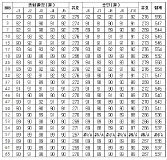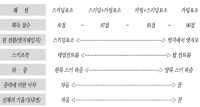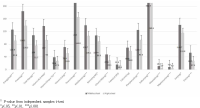Purpose The purpose of this study is to identify the consistency and correlation of referee evaluation according to the judging characteristics in the preliminary and semi-final of the Latin event of dance sports, thereby deriving the problem of referee reliability and suggesting alternatives for improvement. Methods The method of study is Based on the performance data of 54 amateur Latin dances match organized by the Korea Dance Sports Federation for a total of three years 11,850(preliminary rounds & semi-final). Based on the Kappa statistics and the degree of agreement(pa), the difference in the group of examination characteristics was derived and the correlation between the five Latin events was analyzed. Results As a result of through this study, the consistency of the dance sports referee and the characteristics of the judging in the event were confirmed, and the number of judges tended to be higher when the number of judges was seven, the more the number of subjects was, and the highest level of agreement was more than 70 percent of the judges. In addition, the higher the concordance of each of the five detailed items, the higher the correlation tendency. Conclusion Differences in visual aspects between dance sports judges and the difference in the judges' ratings due to the revision of the rules, the decrease in the number of competitors participating in the competition, the number of people to be eliminated in each round, and the proportion of judges with experience in the competition are different, and these differences affect the judges and show up in the scores. The Latin dance sports events based on objectivity and reliability to improve the correct standards of judges to find the same raters, work will be required and an assessment element. With a systematic way in and to carry out the review curriculum and educational development is considered necessary.
Purpose This study is a phenomenological research which tries to describe the subjective experience and to analyze multi-layered meanings, and it finds out the men's training experience and meaning. The purpose of this study is to investigate why the men do Yoga and what the subjective meaning of Yoga experience, and the study examines critically whether Yoga experience especially focused on women is against gender performance and dominant body discourse. Methods For the study, 6 middle & young-old aged men who do Yoga more than 6 months every week are selected as participants. Results The meaning of Yoga for middle & young-old aged men in their lives is as follows. First, it is hard for men to experience Yoga because of social and cultural background. Finding Yoga class which takes men's membership is difficult. Second, middle & young-old aged men's physical feature(interest in their health and disease) and personal background(women friendly daily life) become specific motivation to overcome the barrier to do Yoga. Third, Yoga is 'alterative training', not a training. Yoga is considered as a training which replaces the feature of training called men's sports previously. Fourth, Yoga has a meaning of 'healing' to have our own time. Fifth, Yoga is changed by itself in Yoga culture which is focused on women even though middle & young-old aged men do Yoga for a long time. Sixth, middle & young-old aged men realize that the feature of Yoga is not 'for only women', and they thought it is 'neutral training that men can do too.' Conclusion Consequently, the reason why middle & young-old aged men do Yoga is started from the motivation regarding physical characteristics and personal background, and the main purpose is to cure and to heal our bodies and mind. For them, Yoga means 'alternative training to fit their bodies' and 'their own time'. Moreover, old male adult's training experience and meaning are against gender performance in that it cause a crack in stereotyped gender sports area, but it is notable that there is no intention to resist the dominant gender body discourse.
PURPOSE This study aimed to explore the re-socialization process of college soccer players who rejoin college soccer clubs after dropping out. METHODS A case study approach was employed, and participants were selected using the snowball sampling method. Data were collected through in-depth interviews, participant observation, and literature reviews. The authenticity of the data was validated through triangulation, member checking, and peer debriefing. All research procedures were conducted following approval from the institutional review board. RESULTS The study revealed several key findings. First, participants faced numerous challenges during the re-socialization process into sports, including interpersonal, academic, and emotional difficulties. Second, distinctive features of the re-socialization process emerged, including the determination and effort required for adapting to university life, support from socialization agents within the university, and rapid re-socialization following dropout. Third, experiences within collegiate soccer clubs indicated low barriers to entry for former athletes, academic success through complementary relationships, a hierarchical culture familiar to student-athletes, and enhanced satisfaction in interpersonal relationships and a sense of belonging. CONCLUSIONS This study underscores the importance of institutional support that enables college athletes to participate in sports clubs, facilitating the successful re-socialization of athletes who have dropped out.
PURPOSE This study explores the factors influencing eco-friendly behavioral intentions during sports spectating and infers the causal structure linking each variable to eco-friendly behavioral intentions. METHODS A total of 364 sports fans participated in the survey that collected data on Knowledge of Climate Change (KCC), Awareness of Climate Change (ACC), Attitude of Climate Change (ATT), Subjective Norm of Climate Change (SN), Perceived Behavior Control of Climate Change (PBC), and Behavioral intention to Reduce Single-Use Plastic (INT) during sports spectating. The validity of the measurement was examined through confirmatory factor analysis. Based on the validated data, latent variables’ average scores were reconstructed as input variables for the Bayesian Network, along with demographic characteristics. RESULTS The results of Bayesian network learning indicated that ACC, ATT, SN, and PBC variables directly influence INT. ACC affects ATT and SN, while ACC is influenced by KCC and sex. Conversely, PBC influenced INT but showed no association with the other input variables. SN was found to have the greatest impact on INT during sports spectating, while the influence of PBC was relatively low. CONCLUSIONS The causal structure inferred in the current study using Bayesian network learning provides insights into the previously underexplored relationship structure explaining eco-friendly behavioral intentions of sports fans in the field of sports science. The findings of this study can serve as empirical evidence for sports-related organizations to develop strategies and decision-making processes to promote sustainable sports spectatorship.

Purpose The purpose of this study is conducted to analyze the objectivity of the ski technical championships hosted by Korea Ski Instructor Association (KSIA) and to identify the error sources that affect the score of the competition. Methods To this end, we used the data from the 25th(2009) to 33rd(2017) ski technical championships held by the Korea Ski Instructor Association (KSIA). The data provided by Win Excel 2010 was used to sort out the missing data, such as abandonment, according to the data processing method. The collected data were analyzed by using SPSS 22.0 to calculate the mean and standard deviation of each season, event, and judges, and the Intraclass Correlation Coefficient (ICC). In addition, by using the single facet crossed design(p*j) of the generalizability theory’s G study, the variance component estimates for the participant(p) and the judges (j) are calculated, and the influence (%). Results As a result of the research, it was confirmed that the results of all the seasons and events from the 25th to the 33th events were very consistent, with the objective of .845~.986 higher than the recognition level of .80. In addition, the results show that the relative ratio of the judges to the error of the judging score is very low as a result of the error analysis through the dispersion component estimates. Conclusion In summary, the results of the KSIA evaluation are highly evaluated objectivity and have very low impact on the judges' errors.



Purpose This study aimed to evaluate the nutrient intakes and diet quality of national youth badminton players participating in summer camp training in 2016. Methods Total of 40 middle school players and 60 high school players were included in the study. Two players with skipped meals were excluded from the final target. Food intake data for the 3-day using 24-hour recall method were obtained and analyzed using the CAN-pro 5.0 (Web ver. Korean Nutrition Society, Korea). Differences in nutrient intakes and diet quality were compared between middle school players and high school players using independent samples t-test. Results Intakes of vitamin C, vitamin E, vitamin B6, folic acid, calcium, chloride, magnesium, and zinc in both groups were lower than (RNI) recommended intakes of KDRIs. On the other hand, intake of sodium significantly exceeded the recommended nutrient intake (RNI) of KDRIs in both groups. The NARs (Nutrient Adequacy Ratio) of vitamin C, vitamin B6, folate, calcium and zinc were less than 0.75 in both groups. The NARs of 11 nutrients except for folic acid were significantly lower in high school players. The MAR (Mean Adequacy Ratio) of middle school players was 0.78, significantly higher than 0.64 of high school players. The INQs (Index of Nutritional Quality) of vitamin C, vitamin B6, folic acid, calcium and zinc were less than 0.75 in both groups. The INQs of vitamin A, vitamin B6 and zinc were significantly lower in high school players. On the other hand, the total DDS (Dietary Diversity Score) of high school players was 3.88, significantly higher than 3.29 of middle school players. The DDS of fruit group as well as milk and dairy group were particularly low. Conclusions The results suggest that balanced diet managed by professional dieticians along with nutrition education should be implemented to improve nutrients intake and diet quality of national youth badminton players.
